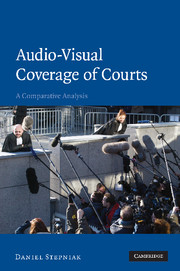7 - Comparative analysis of findings and conclusions
Published online by Cambridge University Press: 27 October 2009
Summary
Introduction
This final chapter undertakes a comparative analysis of the findings of key British, American, Canadian, Australian and New Zealand experiments, studies and experiences with courtroom televising, reviewing and expanding earlier discussion of such findings with respect to specific jurisdictions.
This analysis highlights patterns and common conclusions able to be discerned from the many attempts made to determine both the desirability and dangers of televised court proceedings. In reviewing findings with respect to the main specific concerns or purported benefits, this chapter's discussion emphasises that evidence as to the effects of televising remains, and by its very nature appears destined to remain, inconclusive. It stresses that although it may be inconclusive, available evidence has consistently been found to be sufficiently positive to reassure courtroom participants and the public in countries experimenting with such coverage, as well as those in other jurisdictions considering the introduction of such coverage, of their value.
Questioning the focus which has been placed on evidence as to effects, this chapter notes and illustrates that conclusive proof as to the absence of adverse effects has not been determinative of decisions to permit in-court televising nor of its acceptability.
- Type
- Chapter
- Information
- Audio-visual Coverage of CourtsA Comparative Analysis, pp. 351 - 416Publisher: Cambridge University PressPrint publication year: 2008



